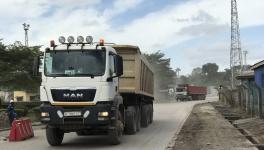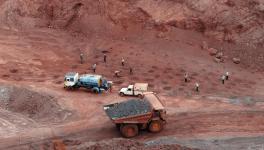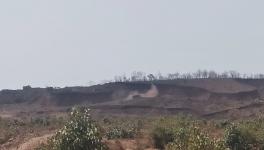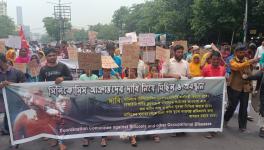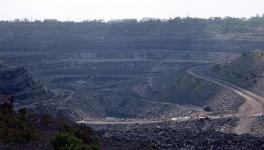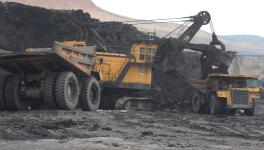One Year Since the Brumadinho Disaster: Locals Struggle, Vale Profits
By Pedro Stropasolas, from Brumadinho
Edilaine Pereira Coimbra never had any connection with Vale, but, like many others, she was by the Paraopeba River when the mud came pouring down on that January 25th, 2019. All she had time to do was cut her fishing lines, get her three children she raised with the income from fishing, and go down a path of no return.Life became meager. Today the fisher lives off a minimum wage she receives from the mining giant Vale and the money she makes selling snacks and candies on the streets of a neighborhood that is not officially registered with the city government of Betim, 25 kilometeres (15 miles) outside Brumadinho.
“I can assure you, everyone just wants their lives back. We want our river to be clean. That would be so much better than having to get that minimum wage now every month. And now it’s not even the minimum wage anymore. They think we are beggars. No one is begging. [Vale] did this, so it has to pay.”
One year ago on Jan. 25, 2019, a Vale dam collapsed in Brumadinho as a consequence of the company’s criminal negligence. It was the biggest man-made social and environmental disaster in Brazil’s history. The death toll reached 259, while 11 people are still missing, buried in the billions of gallons of toxic sludge that devastated hundreds of miles down the Paraopeba River.
In February 2019, a few days after the dam ruptured, Vale signed an agreement to pay up to a minimum wage as emergency relief to the communities affected. Those payments, roughly US$250 a month, are part of the income of 108,000 people who live in the area from Brumadinho down to Pompéu, a city 273 kilometers (170 miles) away from the ground zero of the tragedy.
Now, the company will cut those relief payments in half to at least 93,000 people who live in the 48 cities impacted by Vale’s toxic mud, and will only continue to pay the full amount – which locals affected consider insufficient – to those in the area the miner defined as “hot zone,” encompassing six communities where around 10,000-15,000 people live.
“We know that, by ourselves, we are small. Vale was aware of that too. Otherwise, it would not have let that dam break in our territory. It knew all along that the dam would break, but because it was just a small rural community, it let that happen. Because it was just a bunch of workers. ‘What rights would they have?’” says Jeferson Custodio, the president of the Residents’ Association of Córrego do Feijão, where the dam was located.
“An example of that is the compensation for damages. For this tragedy in Brumadinho, they are small. They are not punitive damages. That means nothing for Vale. They are paying damages, but they record surplus every quarter,” Custódio adds.
The streets of the village would now be deserted if it were not for the huge trucks rumbling by, making locals increasingly concerned about what Vale is not telling them. In the Córrego do Feijão village, 27 lives were lost on that tragic day.
Custódio says that 49 local families have moved away since the disaster, trying to recover from the trauma or for because Vale bought their properties.
The effects of the collapse of the Brumadinho dam are noticeable. Locals face poor access to clean water, health care, and public policies. Farm activities are languishing, and tourism, once a major sector in the area, is no longer possible. Residents are becoming physically and mentally ill as they watch the ruin of rural and river communities.
As their livelihoods have been destroyed, locals have no perspective to generate income again.
“No one is able to work anymore, because everyone is living under medication. Everyone. I myself am taking so many drugs,” says small farmer Maria Aparecida da Silva Soares, who grew vegetables for 21 years before the dam break, adding that the medications she needs cost almost all the relief payment she is expected to receive from Vale now that its cutting down on the aid.
Meanwhile, in the business world, Vale shows no more signs of the trauma it inflicted in the area one year ago. The newspaper Folha de S. Paulo on Jan. 17 reported that the company recovered its market value and its stock hit its highest since before the dam burst, reaching estimated R$301 billion (US$75.25 billion), R$5 billion (US$1.25 billion) more than its records when the toxic sludge devastated hundreds of thousands of lives in Minas Gerais state.
Before that, in December, the mining company had announced that it would pay shareholders R$7.25 billion (roughly US$1.8 billion) due to the company’s positive results in 2019. The amount is higher than the investments made in social and environmental projects for the remediation of the damage caused in Brumadinho, which cost the company R$6.55 billion in damages and construction work last year.
A desolate community. At least 49 families moved away from the small Córrego do Feijão village after the worst man-made disaster to ever hit Brazil. Photo: Atamaio Ferreira
Emergency relief
Even though Vale advertises its reparation work in Brazil’s mainstream media, the reality of those affected by the dam burst is grim.The new agreement to extend the payment of emergency relief for another ten months – the original deal should be in effect until February 2020 – will cut in half the amounts paid to 85 percent of the people affected by the disaster.
The hearing where that extension was defined took place in November 2019 and the communities were not allowed to take part. The negotiations were made only between Vale, the Minas Gerais State Prosecutor’s Office, the Federal Prosecution Service, the Minas Gerais State Public Defender’s Office, the Federal Public Defender’s Office, and the Minas Gerais state government.
The hearing is being challenged by the Movement of People Affected by Dams (MAB), which argues that the new agreement only benefits Vale, reducing the company’s costs with compensation for damages.
MAB coordinator Joceli Andrioli says that the decision casts doubt about the credibility of the country’s justice system.
“It would be better not to reach an agreement at that hearing than to reach such a poorly-made agreement,” Andrioli argues. “When the judge set a hearing date after that one, with the survivors, it was only to announce that the deal had already been made, and there was nothing else to discuss. This attitude by the justice system is pitiful, and it’s so naïve to make this deal.”
Luiz Paulo Siqueira, of the national board of the Movement for People’s Sovereignty in Mining (MAM), says that extending the payment of emergency relief was “important and necessary,” but the MAM believes that reducing the number of families that will receive the full payments is an answer to “Vale’s strategy to deny the rights of those affected by it.”
The Minas Gerais state prosecutor André Sperling Prado, a member of the task force investigating the Brumadinho and Mariana cases, agrees that the deal is not ideal for the survivors, but he argues that, if they didn’t settle for the reduced payments and the case was taken to court, the judge could rule against extending the payments.
The prosecutor argues that the agreement signed right after the tragedy aimed to provide emergency aid to the families. “It was a way to help people get by until they receive the final payment of damages.”
Those who never received aid
Josiel Vieira dos Santos is a construction worker and is currently unemployed. He lives off informal jobs he finds in the Cruzeiro neighborhood, in the town of Betim. As he looks at the Paraopeba River, devastated by the toxic sludge, he doesn’t feel safe about using the water from his cistern. He is concerned about water quality, because Vale only assesses these levels as far as 100 meters (328 feet) from the riverbed. The mining giant, nevertheless, gave him a water tank. Santos received no support aside from that.Since the day of the rupture, his family has been unable to access emergency relief because the street where they live is not registered with the city government.
“They gave me a 5,000-liter water tank and they come here to supply water every other day. They even set up the tank for me, but they still won’t recognize my address,” he reports.
Even though Santosâ family received a water tank from Vale, they canât receive emergency relief payments for the lack of proof of residence. Photo: Pedro Stropasolas
Santos’ case is not the only one. The Minas Gerais public defender Carolina Morishita Mota Ferreira says that many locals who were affected have been struggling to prove they have the right to receive aid because they can’t produce documents to prove where they live.The public defender’s office found at least 12,000 cases of people who are not eligible to receive emergency relief payments because they can’t provide the documentation Vale requires, even though they have been affected by the Brumadinho dam collapse.
“No one was prepared to have their lives destroyed by Vale. People don’t keep all the receipts of everything they buy, of every penny they make, because they’ve never thought that one day someone would destroy everything they have built,” Ferreira argues.
Residents who live more than 1 kilometer (0.6 mile) away from the riverbed of the Paraopeba are also unassisted and unable to access the miner’s emergency relief payments.
Joana Gonçalves de Almeida and Juventino de Almeida have still not received emergency aid. Photo: Pedro Stropasolas
Tourism industry ruined
With no clean water and distribution by Vale, the community of Cachoeira do Choro, in the town of Curvelo, became a ghost town. Since the toxic sludge reached the city coming down the Paraopeba River, 195 kilometers (120 miles) away from the dam that ruptured, it ruined the local tourism industry.“Now that the river is contaminated, no one comes here anymore. It’s all over. We’re living off Vale’s alms,” says Geneci Cristina Barroso, the owner of a local bar that provided a livelihood to her family.
“My daughter, my son, and his wife left. My grandchildren stayed. And God. It was hard enough to make ends meet with the aid, earning a minimum wage. Now there is nothing left,” she laments.
Geneci is concerned because she can’t grow food anymore. “You grow and harvest something, but you can’t sell it. So you lose it, or it dies, because of the water, which is contaminated. We can’t keep a vegetable garden to have something to eat anymore.”
A small business owner, Geneci Cristina Barroso now depends on Valeâs âalmsâ. Photo: Pedro Stropasolas
Farming compromised
Minas Gerais state authorities conducted a preliminary survey and found that 498 small family farmers were affected, directly or indirectly, by the toxic sludge.But the most effective measure taken by Vale in this sense only addressed the problems of 91 local rural producers. The company offered R$15,000 (US$3,500) to those who had farms in the so-called “salvation zones,” encompassing the area up to 10 kilometers (6.2 miles) away from the Brumadinho dam.
Valeria Carneiro, a farmer from the Pastorinhas Settlement, 12 kilometers outside the center of Brumadinho, argues that the minimum wage paid monthly by Vale is “meaningless,” and that it’s not enough to bear the cost of even one third of the expenses of a rural property. Twenty families grow agroecological food in the settlement where Carneiro lives.
Once known as the green belt of the greater Belo Horizonte area, the Paraopeba Valley is now a place where farmers struggle with lack of clean water and crippling debt. Photo: Pedro Stropasolas
Even those who are effectively receiving emergency relief from Vale and have better conditions to keep their farms struggle to sell their produce at the Belo Horizonte farmers’ markets, as customers are not willing to buy fruits and vegetables from the Paraopeba.
Independent technical support
The community leader Joelisia Feitosa, from the town of Joatuba, says that one of the hopes for the residents affected by the disaster is the work of independent technical support teams, in which experts produce reports about the communities affected without the participation of employees of the company that caused the damage.A preliminary agreement with state authorities and Vale secured the technical support to the communities in February 2019, and the organizations were chosen by committees of the locals affected. Now the company is refusing to respect and formalize the plans for the technical support teams to conduct their work in the five areas defined between the cities of Brumadinho and Pompéu.
The teams can only start their fieldwork after a court decision. The prosecutor André Sperling says that Vale has been making it hard for them to carry out their research, an attitude similar to what the company did after a dam broke in Mariana in 2015. Only three of the 21 territories affected then received technical support.
“Obviously when those experts are on the side of those who were affected, they [locals] will become more aware of their rights and will be able to demand those rights more effectively. And Vale doesn’t want that,” the prosecutor argues. He expects the expert teams to start their work early this year.
While the communities affected by the dam disaster demand justice and compensation, miners continue to operate in the area, disturbing residentsâ lives. Photo: Pedro Stropasolas
History
On January 25, 2019, an avalanche of 12 million tons of cubic meters of toxic waste poured from a Vale dam destroying a 300-hectare area of land. Homes, vegetable gardens, and workers who were having lunch at the company’s cafeteria were swept by the mudslide. Hundreds of lives were lost and 11 bodies are still buried in the mud. Rescue teams continue to search for the victims to this day.No Vale employees were arrested. Last Tuesday, the Minas Gerais Prosecution Service filed charges against Vale’s former CEO Fabio Schvartsman and other 11 employees, as well as five workers of the German company Tuv Sud who certified that the dam was safe, for aggravated first-degree murder.
The Minas Gerais Water Management Institute (Igam) found signs of contamination in 223 kilometers (138 miles) down the Paraopeba River and recommends that locals do not use the water for any purpose. Without access to proper toxicity tests, an estimated 1.3 million people are at risk of being contaminated by heavy metals.
Brasil de Fato contacted Vale, but its PR office did not immediately respond to requests for comment.
CREDITS
Story, footage, and photos: Pedro Stropasolas | Edited by: Rodrigo Chagas | Designer: Fernando Bertolo | Video editor: Leonardo Rodrigues | Radio version (Portuguese): Geisa Marques | Coordinators: Camila Maciel, Vivian Fernandes, and José Bruno Lima | Radio coordinator: Camila Salmazio
Get the latest reports & analysis with people's perspective on Protests, movements & deep analytical videos, discussions of the current affairs in your Telegram app. Subscribe to NewsClick's Telegram channel & get Real-Time updates on stories, as they get published on our website.











